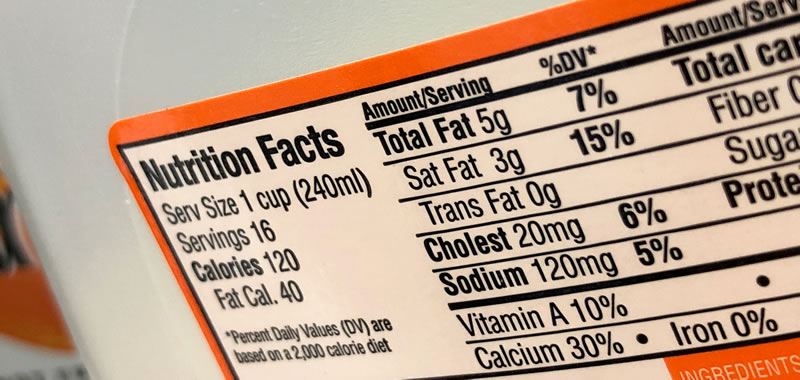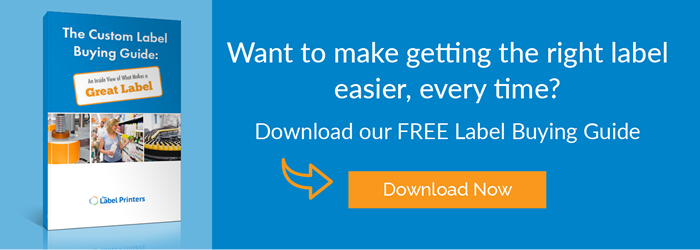
Peek down any grocery aisle. As you watch the shoppers considering their choices, you’ll notice an interesting phenomenon. While many of the shoppers will seem drawn to the striking imagery and bold colors that grace the front of the boxes, bottles, and jars that line the shelves, it’s the back of the products that hold their attention the longest. They’re analyzing nutrition fact labels.
As consumers get more and more conscious of what they put into their bodies, they increasingly rely on nutrition labels to help them make good decisions about their health.
According to FDA survey results released in 2016:
- 77 percent of American adults say they use nutrition fact labels at least some of the time. 16 percent say they always use them, and 34 percent say they use them most of the time when buying products.
- 79 percent of American adults say they look at the nutrition label often or sometimes when buying a product for the first time.
- Among those who look at it often, 55 percent do so “to see if there is an ingredient that you or someone in your family should avoid.”
That last statistic is critical for brands that target consumers who follow special diets (such as gluten-free) or who prefer natural or less-processed foods. These buyers may scrutinize nutrition labels with the laser-like focus of researchers decoding an ancient text.
Nutrition Labels and the Law
Of course, nutrition fact labels are more than helpful hints for consumers. They’re required by U.S. law on nearly all food and beverages. (A handful of product types, such as raw vegetables, are exempt.)
Food labeling requirements are complex and extend beyond the nutrition facts label. Any food manufacturer launching a new product should take the time to understand its government-mandated label obligations. If you need guidance making sure your labels meet the regulatory requirements, an experienced label vendor will be able to help.
If your products’ nutrition labels have been around for a while, now is the perfect time to revisit your labels. Why? Because the FDA recently unveiled a revised set of requirements that, take into account the latest thinking about dietary needs. The refreshed design, the FDA says, “will make it easier for consumers to make informed decisions about the food they eat.”
When Do the New Nutrition Label Requirements Go Into Effect?
Initially, the FDA set the deadline to comply with the new requirements at July 26, 2018. After industry and consumer groups expressed concern about the date, the FDA extended it to Jan. 1, 2020, for companies with $10 million or more in annual food sales, and Jan. 1, 2021, for companies with less than $10 million in food sales.
What Are the Major Changes?
The new nutrition facts label retains its rectangular shape and light and dark contrast. Changes include:
- The calorie count in a larger, bolder font.
- “Serving size” and “servings-per-container” are also larger. Serving size must match what a typical person would consume, not what they should consume (for example, most people drink an entire can or bottle of soda in one sitting).
- “Added sugars” must now be listed.
- “Calories from fat” is no longer required.
- Certain nutrients have been added (vitamin D and potassium) and others have been eliminated (vitamins A and C).
The FDA provides a rundown of all the changes on its website, as well as several examples of acceptable label formats, including versions that fit on smaller packages.
Nutrition Fact Label Tips
In addition to meeting the basic FDA requirements, there are many ways you can improve your product labels to help your customers understand the nutritional benefits of your product and its ingredients.
- Go big and bold. The FDA doesn’t specify which font you should use for your nutrition labels, although it does emphasize legibility. Large print and readable fonts can help those with poor eyesight — as well as those who are in a rush — read your nutrition labels. Your label printer can help you choose a font and font size that works for your customers.
- Think about the front of the package. For now, front-of-package nutrition information is voluntary, but many of America’s most popular food brands have jumped on board with the Facts Up Front The idea is to provide useful nutrition information to consumers in a convenient, easy-to-read format without requiring them to turn the package over.
- Choose durable materials and ink. Your buyers will still want to read your product’s nutrition information after they take it home from the store. Environmental factors such as heat, cold, moisture, and light can cause labels to tear, peel off, and fade, destroying or obscuring nutrition facts. Ask your label printer about materials, adhesives, and ink that can hold up to the elements.
Like many aspects of your custom product labels, nutrition fact labels are more complicated than they may first appear. It helps to have a knowledgeable, experienced expert at your side. Learn more about what goes into getting a great label with our free ebook, “The Custom Label Buying Guide.”

